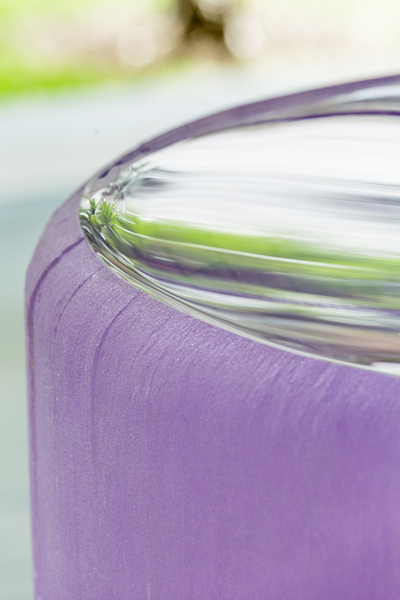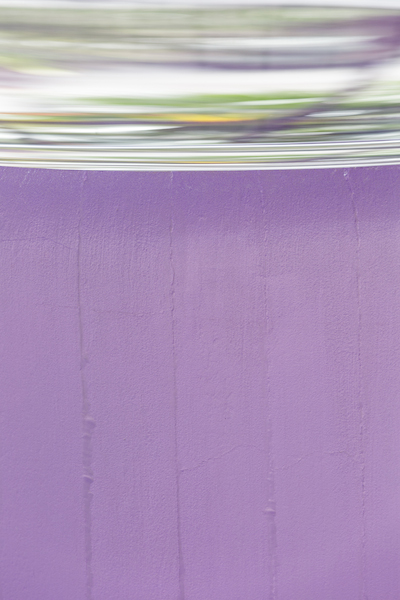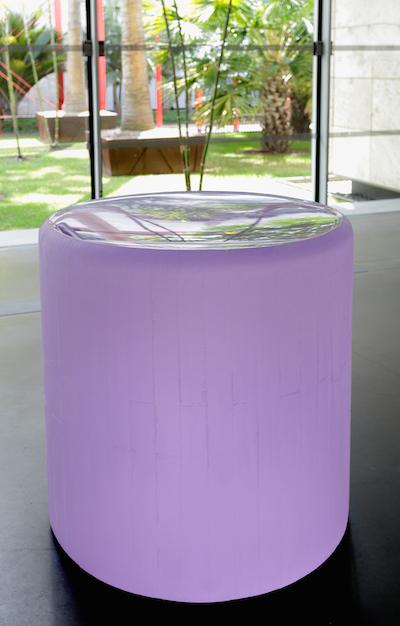In 1975, just after graduating from the Rhode Island School of Design, Roni Horn traveled to Iceland. She found herself captivated by the qualities of the place, most especially its landscape and weather, which could transition from sunshine to a hailstorm and back again in a matter of minutes. Thus began her desire to capture and reflect moments of instability and change, a theme that she has explored through serial photography, drawing, and sculpture. In making objects, Horn has worked with highly expressive materials such as water or gold, as well as the subjectivity of written language.
Paradox is at the heart of Horn’s practice, as it relates both to our physical world and to the shifting and fluid attributes of personal identity. In the 1990s, Horn began making large sculptures in glass, a material that, since her childhood, she found to be the most ideal expression of color. Glass itself is a contradiction: despite its appearance, it is neither solid nor liquid, but referred to equally as a disorganized solid and a super-cooled liquid. Continuing her explorations into multiplicity, perception, and identity, Horn’s work in glass plays with dualities: form and image, lightness and weight, strength and fragility.
 Roni Horn, Untitled (“The sensation of satisfaction at having outstared a baby.”), 2013, gift of the 2014 Collectors Committee, with additional funds provided by Steve Tisch, © Roni Horn
Roni Horn, Untitled (“The sensation of satisfaction at having outstared a baby.”), 2013, gift of the 2014 Collectors Committee, with additional funds provided by Steve Tisch, © Roni Horn
Roni Horn’s Untitled (“The sensation of satisfaction at having outstared a baby.”) is a solid form of glass. Its rough sides evidence the process of casting, while its pristine and slightly concave top surface reveals, within its interior, a seemingly endless depth. Rendered in vibrant lavender hues, the sculpture provides a stage for the play of reflections brought on by the presence of natural light. In doing so, Horn invites contemplation between the object, the viewer, and their surroundings, as the 3,300 pounds of glass delicately changes according to its conditions.
In order to make a work of this clarity, the glass was poured gradually over 24 hours and cooled with precision for four months. It is displayed exactly as it appeared following the process of its creation. Though exceedingly complex to produce, the resulting object could be compared to a poem: precise, with nothing extraneous. Horn herself maintains a writing practice, and literary references surface throughout almost all of her work. In this instance, she sources the title from a piece of short fiction by artist Hollis Frampton.
 Roni Horn, Untitled (“The sensation of satisfaction at having outstared a baby.”) (detail), 2013, gift of the 2014 Collectors Committee, with additional funds provided by Steve Tisch, © Roni Horn
Roni Horn, Untitled (“The sensation of satisfaction at having outstared a baby.”) (detail), 2013, gift of the 2014 Collectors Committee, with additional funds provided by Steve Tisch, © Roni Horn
Untitled (“The sensation of satisfaction at having outstared a baby.”) draws on the history of minimalism and could be compared to—and displayed alongside—works by Los Angeles Light and Space artists such as James Turrell or Helen Pashgian, Finish Fetish artists such as John McCracken, or Donald Judd’s explorations into form and variation, exemplified by his installation of one hundred aluminum boxes. In fact, Horn visited Judd in Marfa, Texas, following his invitation to install a sculpture there, and she was acutely influenced by that experience.
 Roni Horn, Untitled (“The sensation of satisfaction at having outstared a baby.”) (detail), 2013, gift of the 2014 Collectors Committee, with additional funds provided by Steve Tisch, © Roni Horn
Roni Horn, Untitled (“The sensation of satisfaction at having outstared a baby.”) (detail), 2013, gift of the 2014 Collectors Committee, with additional funds provided by Steve Tisch, © Roni Horn
However, Horn’s voice and perspective are drastically different. Her work would be better compared to that of Agnes Martin; in the case of both Martin and Horn, we can trace the presence of the artist’s hand or her sentiments, marrying an awareness of human fragility with the geometric forms of their mostly male counterparts. As artist Felix Gonzalez-Torres wrote, “Some people dismiss Roni’s work as pure formalism . . . they cannot see the almost perfect emotions and solutions her objects give us . . . a new landscape, a possible horizon, a place of rest and absolute beauty.”
Jarrett Gregory, Associate Curator, Contemporary Art



